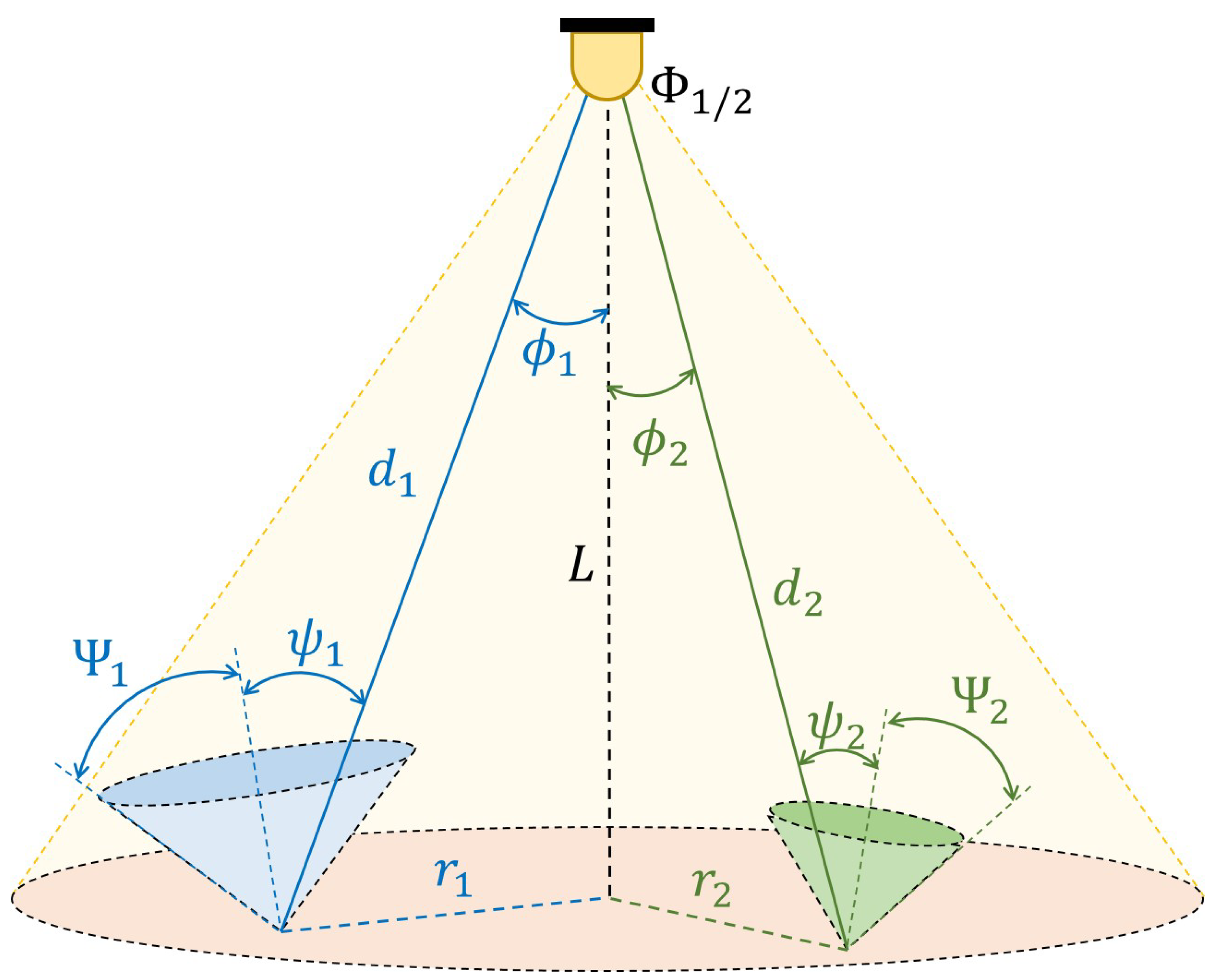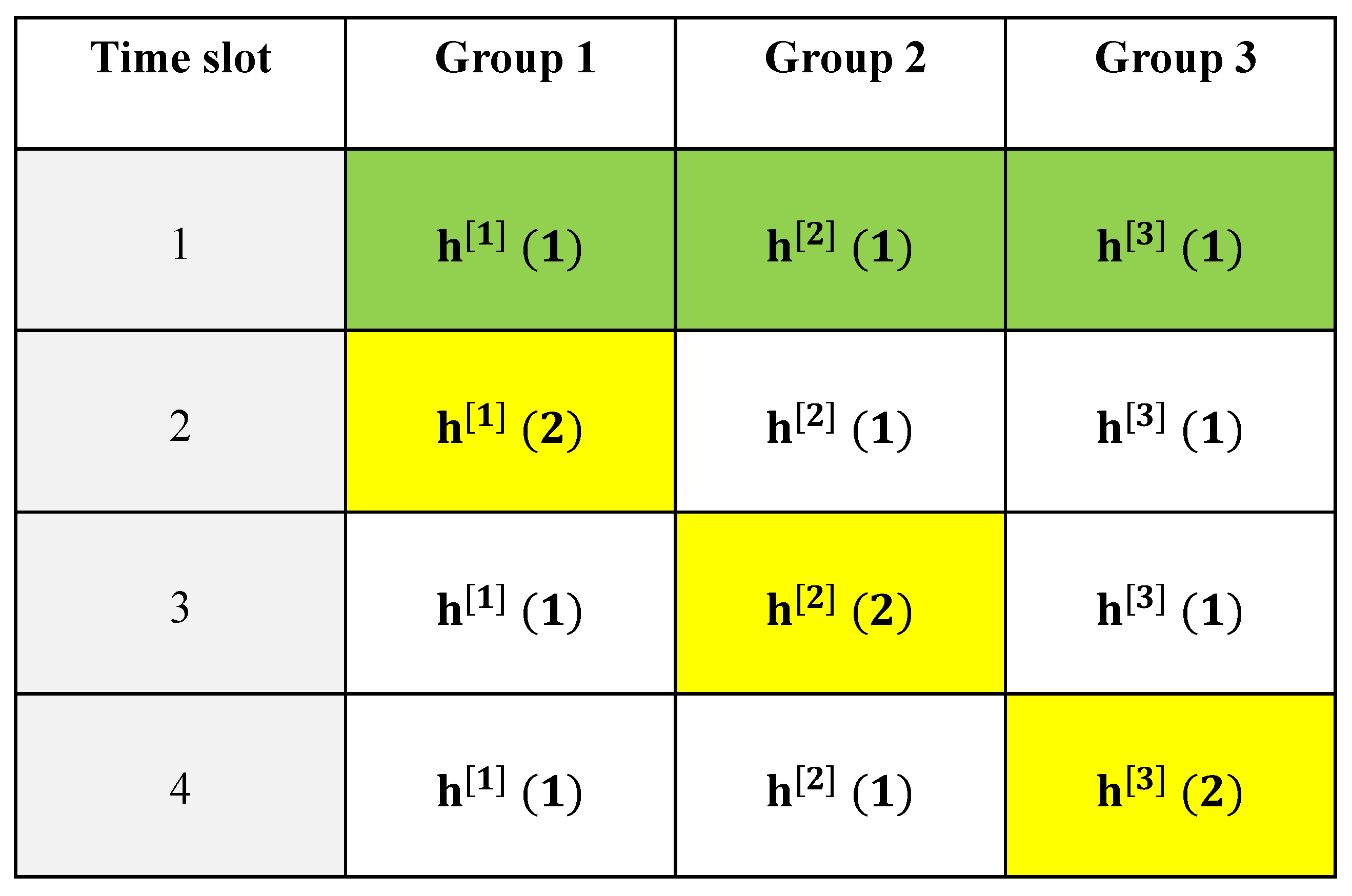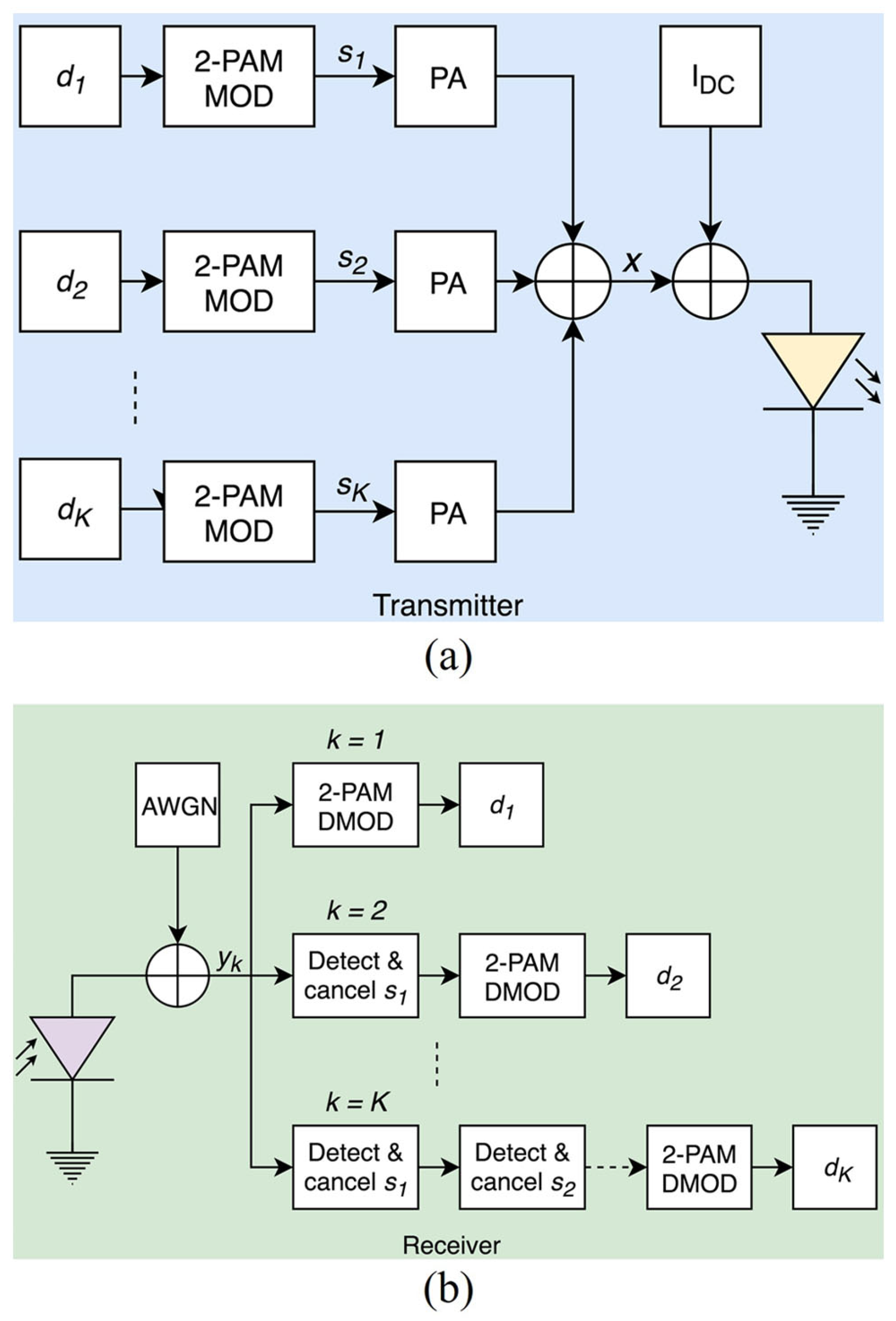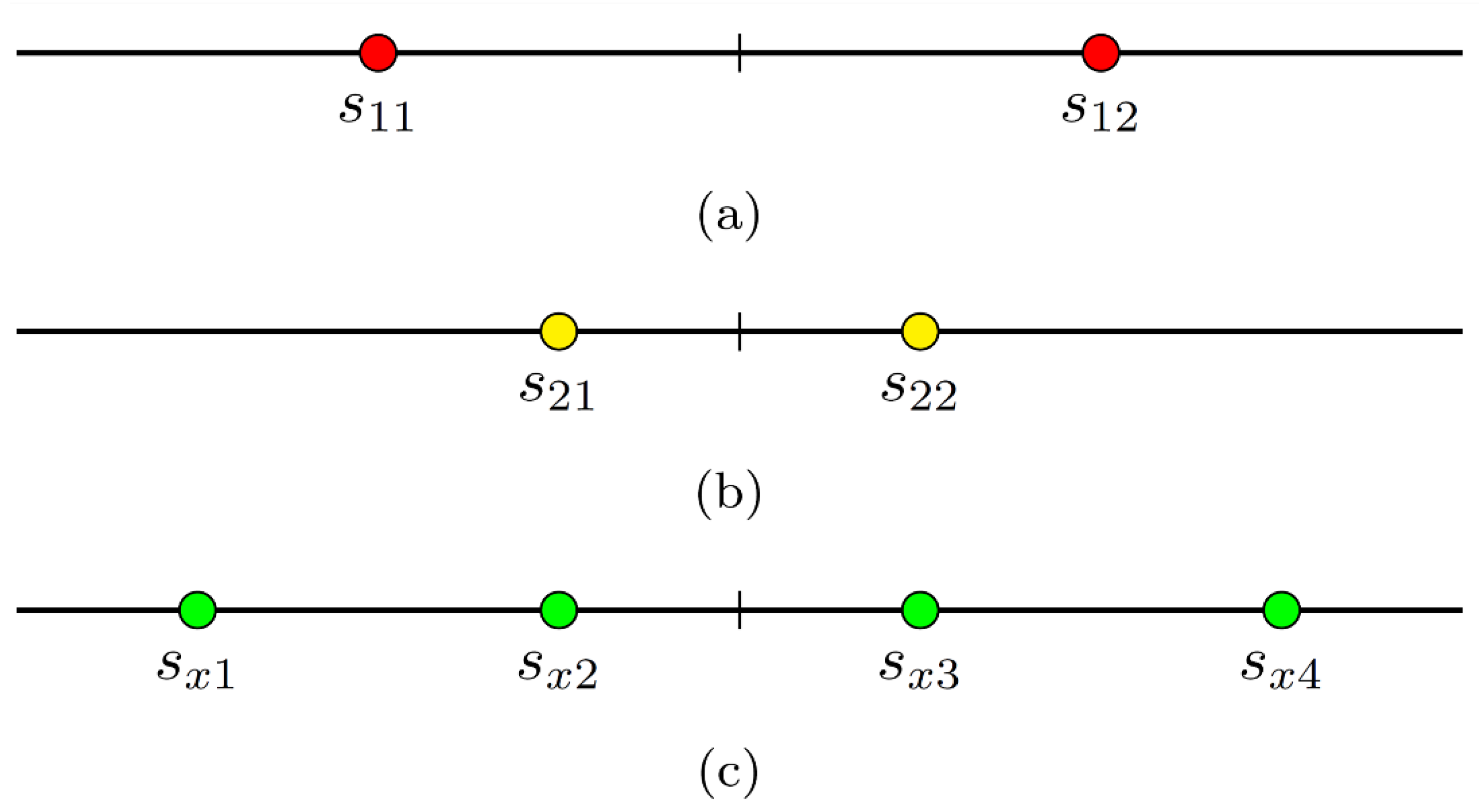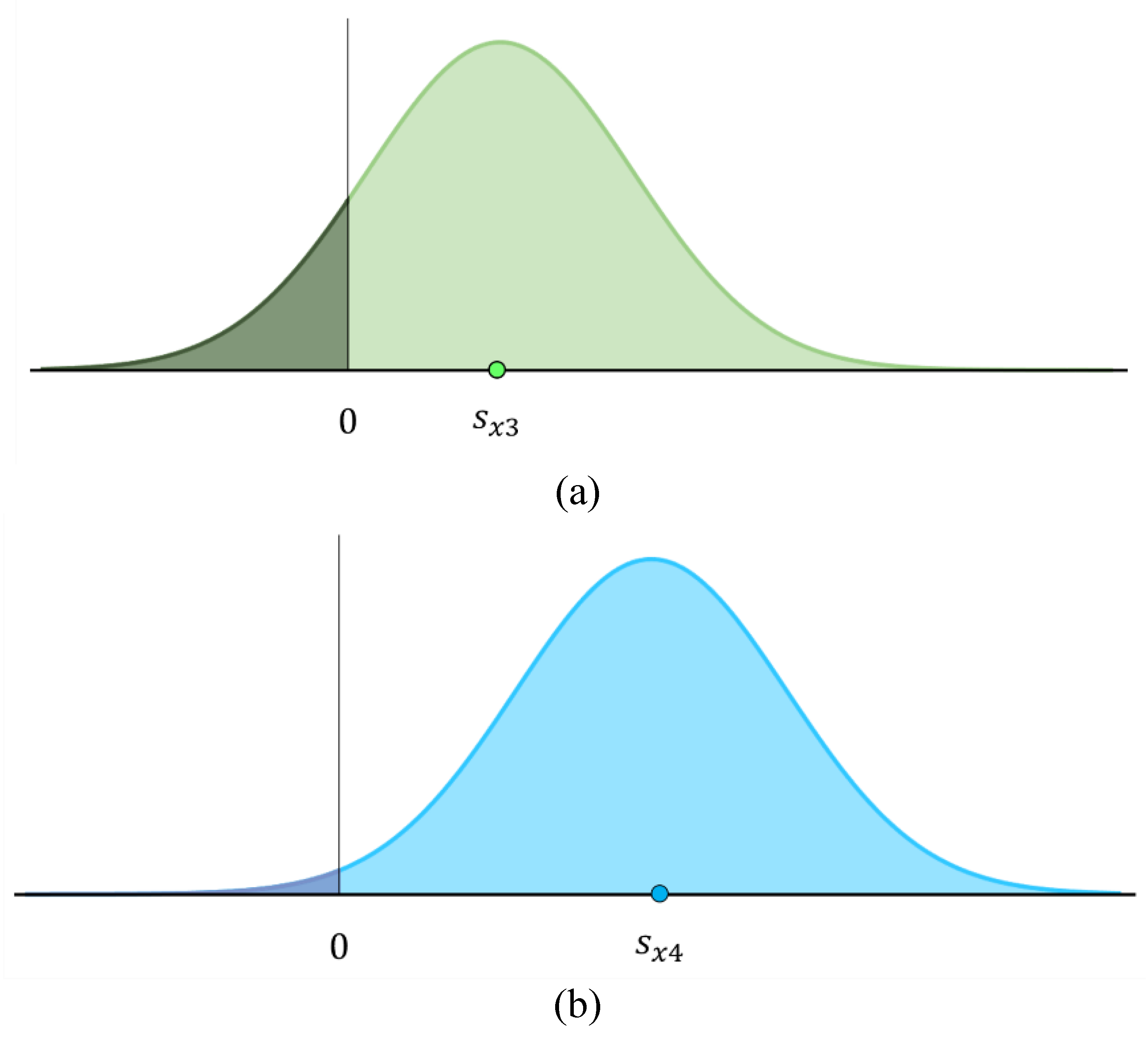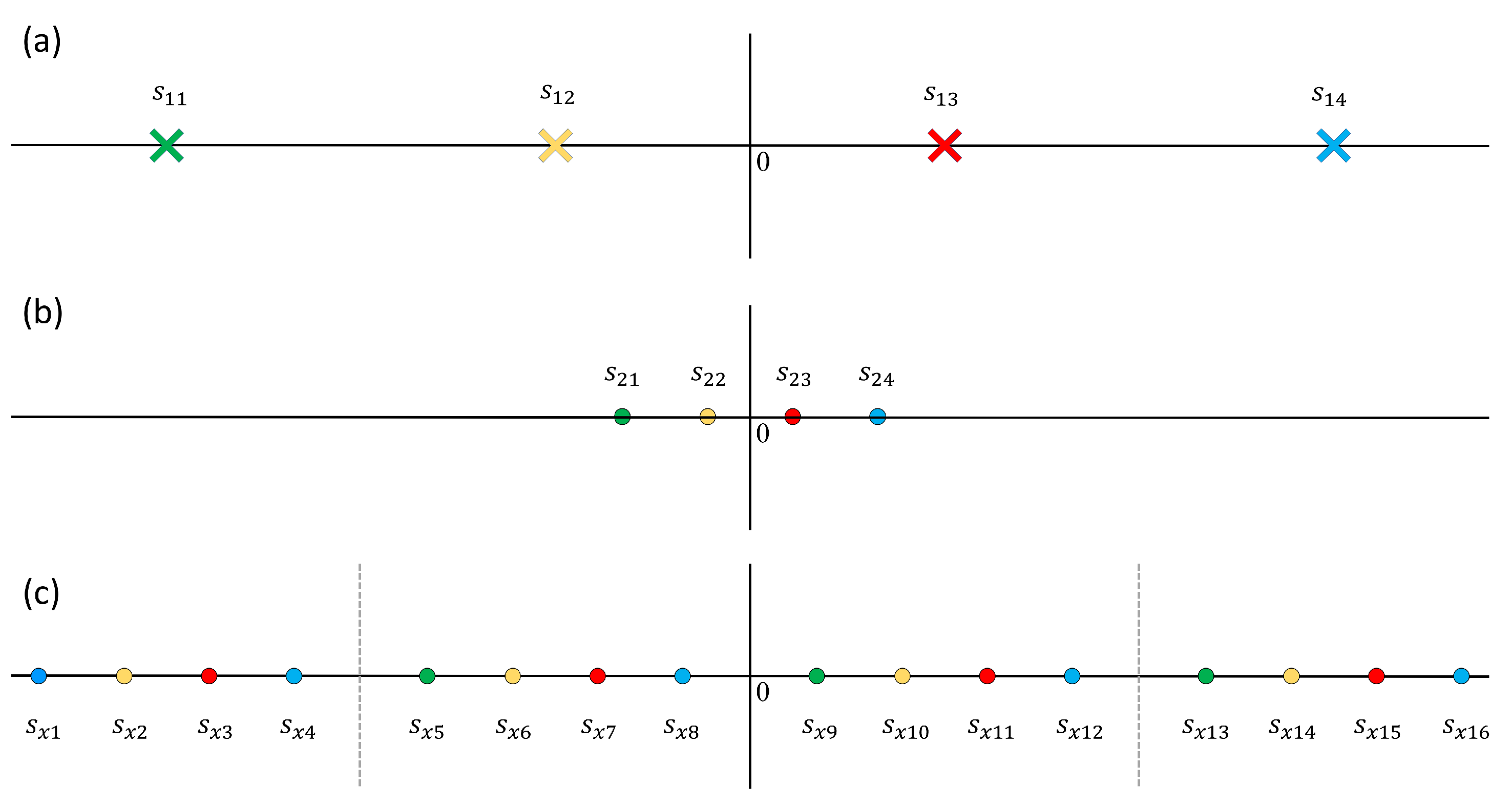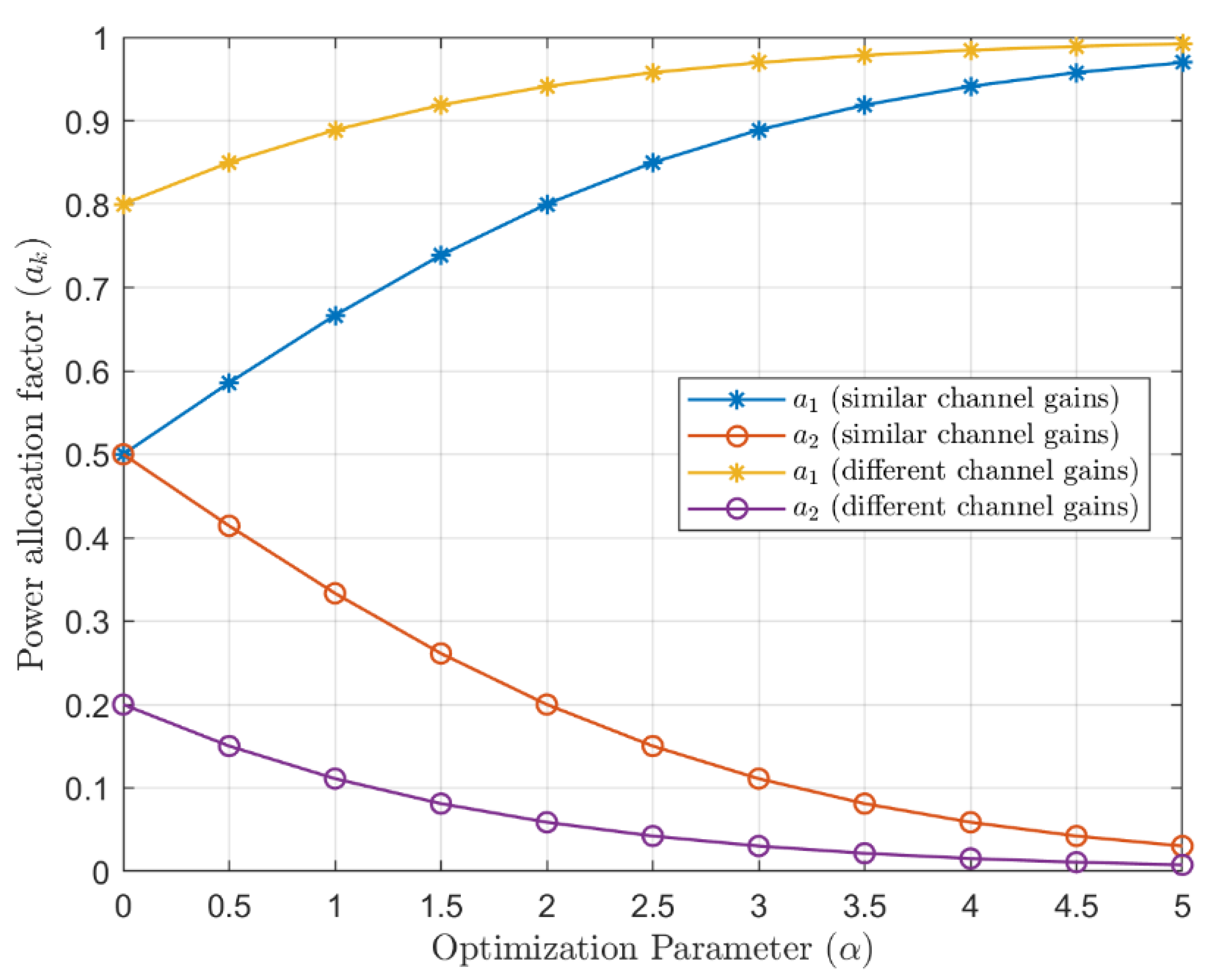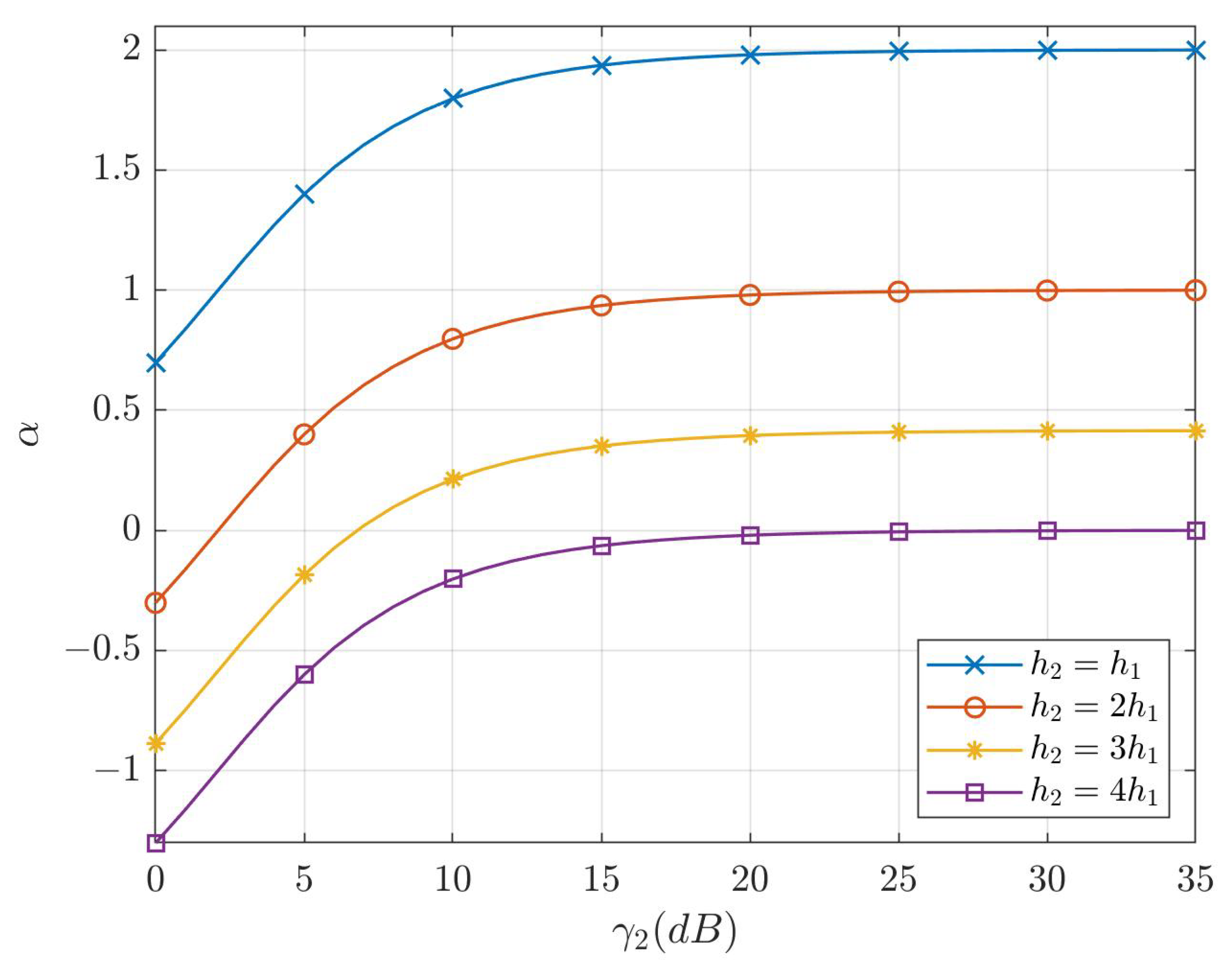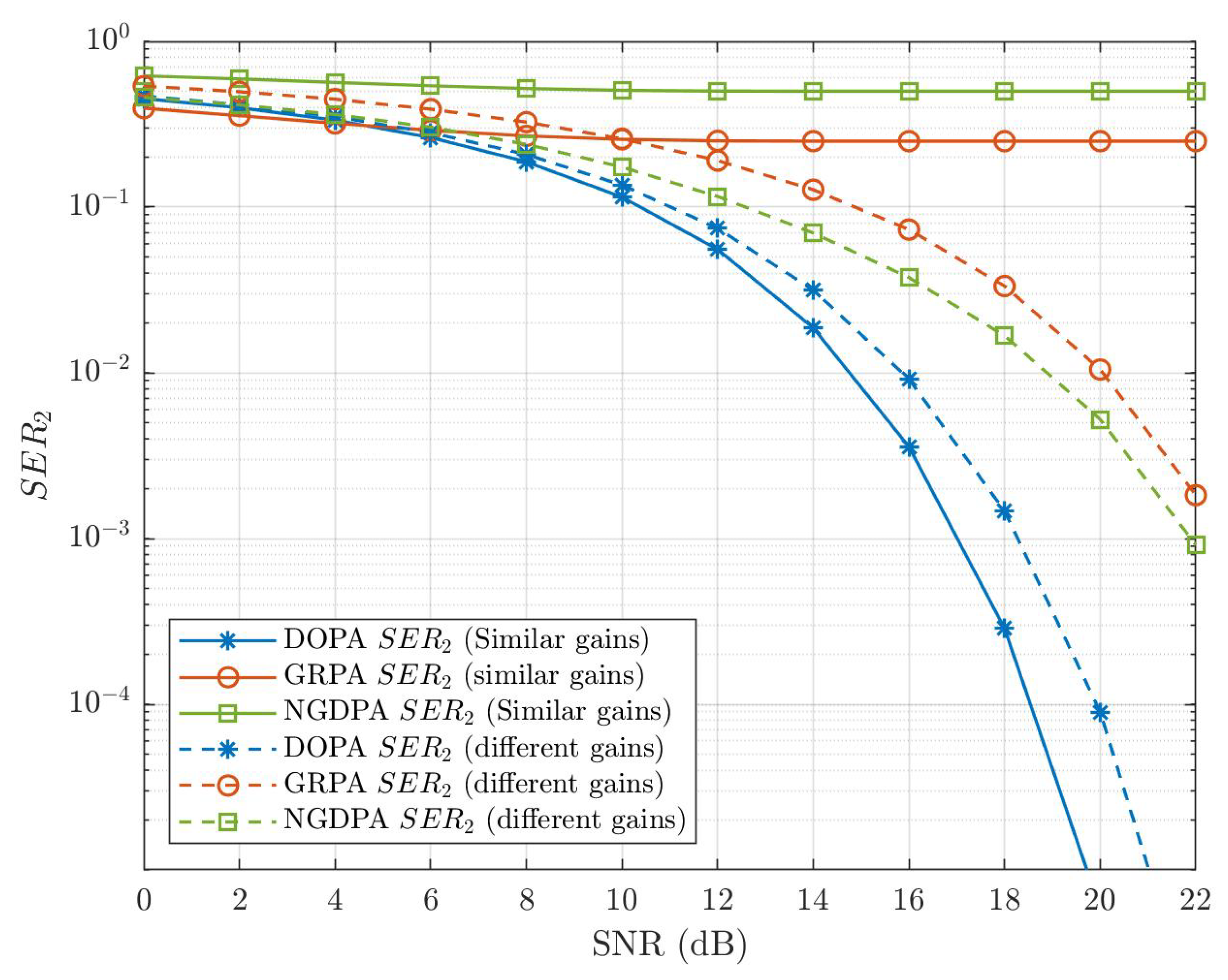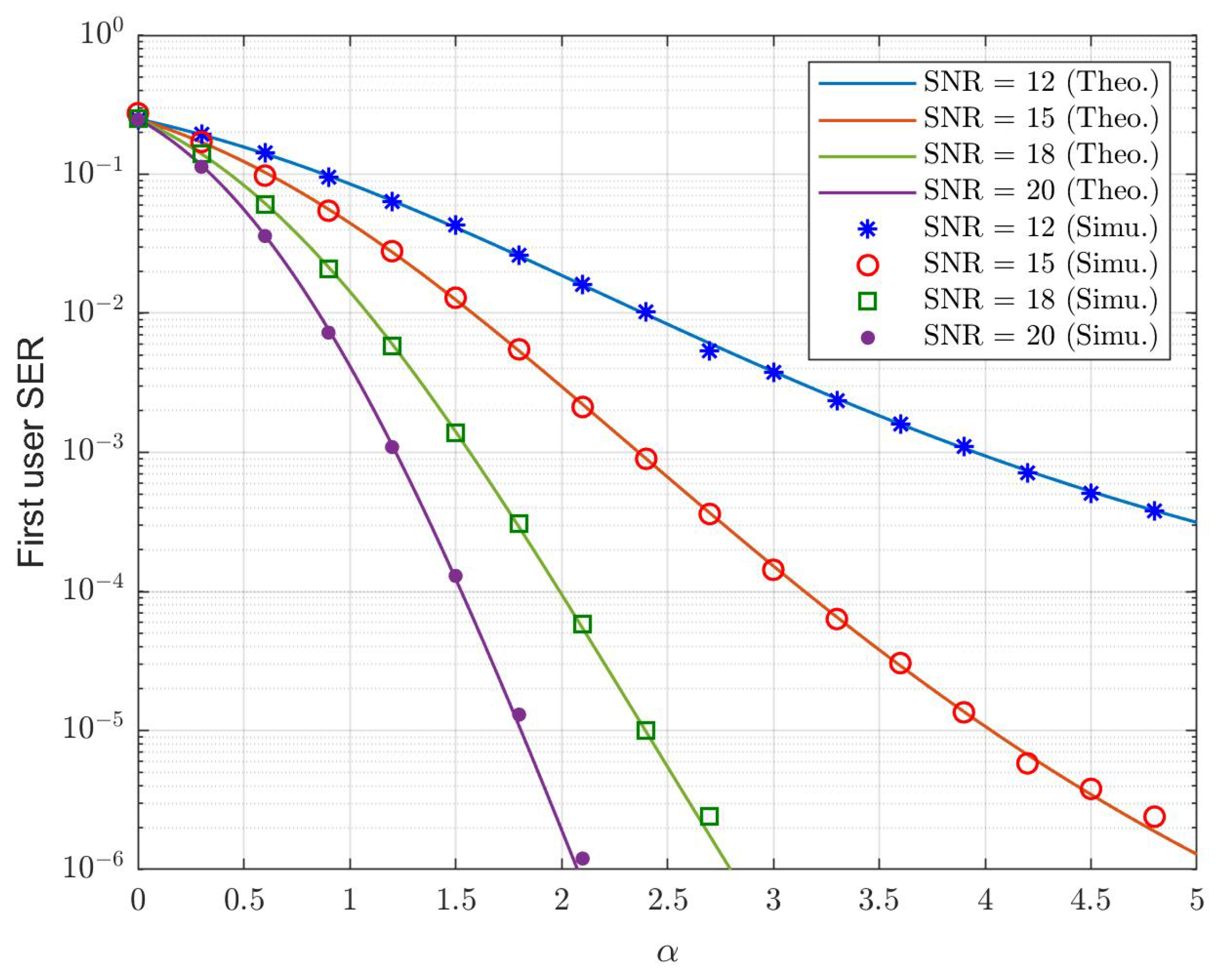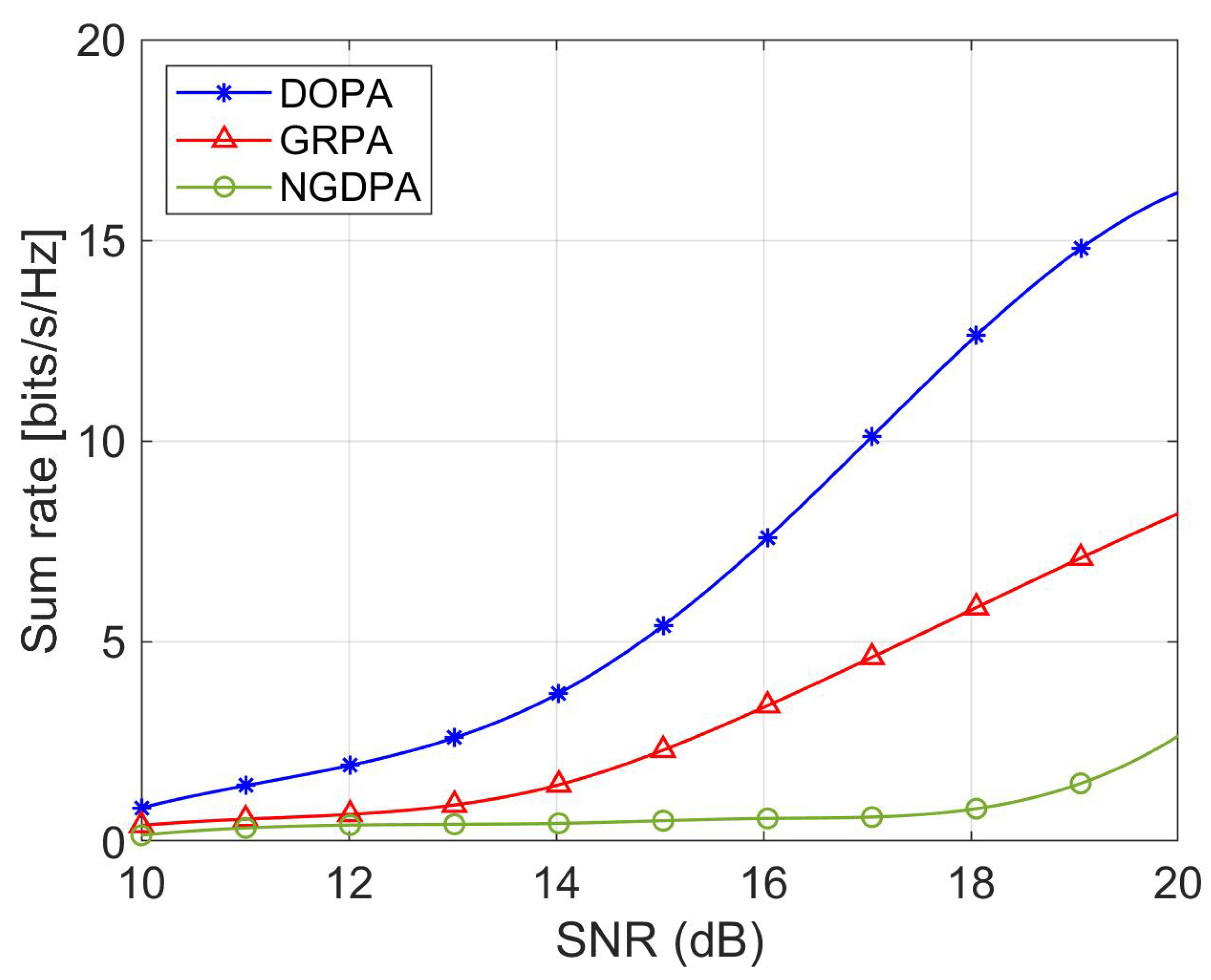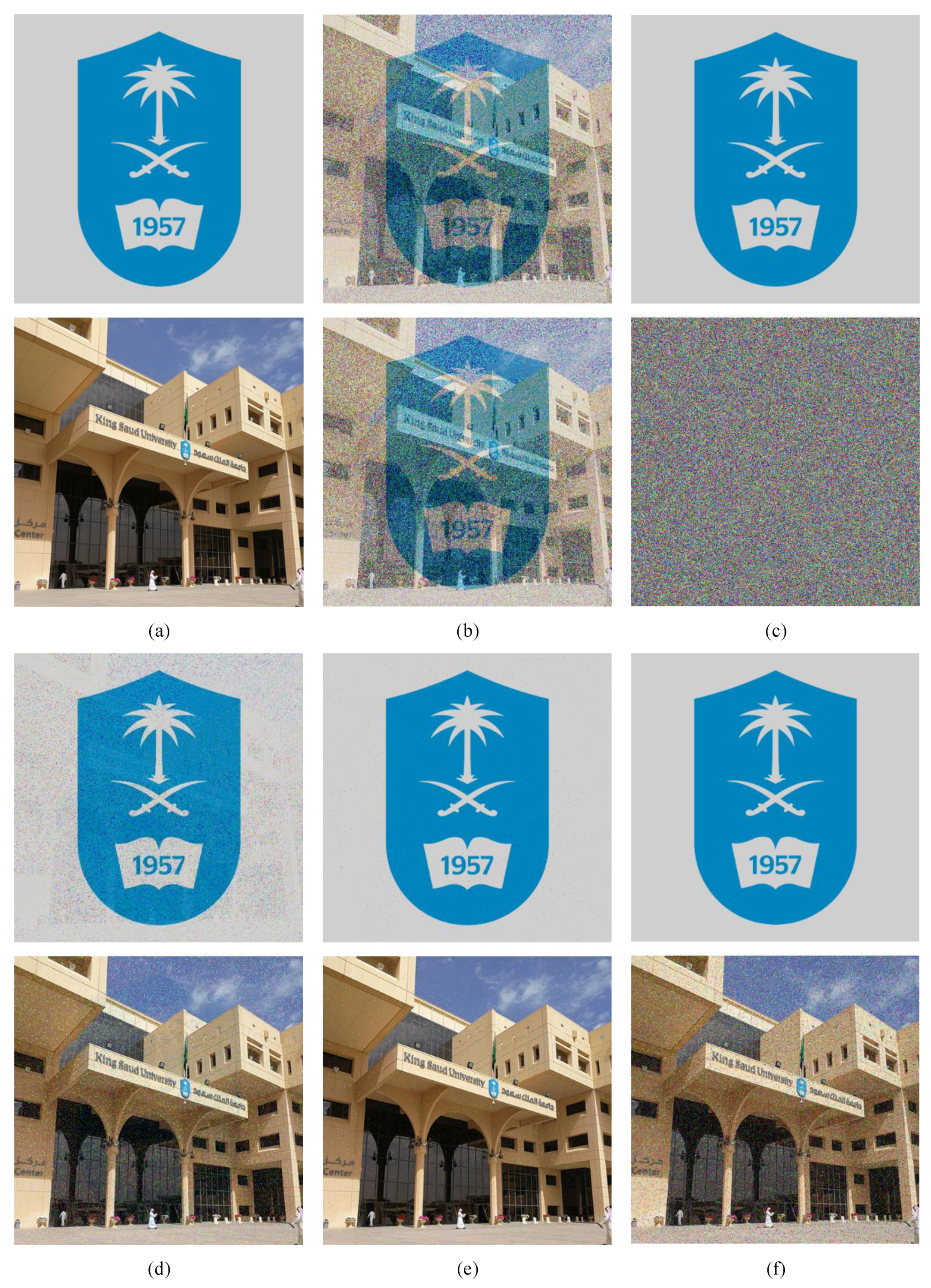1. Introduction
Visible light communication (VLC) is one of the most promising technologies that is attracting more attention as the demand for wireless data communication continues to increase. As the radio frequency (RF) spectrum is becoming more and more saturated, RF-based technologies, such as cellular networks and Wi-Fi, will no longer keep up with the growing demand for more data rate [
1]. In contrast, VLC systems occupy the license-free light spectrum which is out of the RF spectrum and can provide a much wider bandwidth spanning approximately from 400 THz to 800 THz [
2,
3,
4]. VLC is an alternative technology for indoor wireless communications which is expected to be an integral part of the future wireless networks, such as networks used beyond 5G, due to its energy efficiency and its ability to achieve high data rates [
5,
6]. Although the most potential applications of VLC are in indoor scenarios, VLC has many promising applications in outdoor environments such as vehicular VLC (V-VLC) as an alternative vehicular access solution to RF-based vehicular communications [
7,
8,
9].
In order to realize a multi-user VLC system, a multiple access (MA) scheme is required. Many MA schemes have been proposed for VLC such as time division multiple access (TDMA) [
10], space division multiple access (SDMA) [
11], code division multiple access (CDMA) [
12], and orthogonal frequency division multiple access (OFDMA) [
13]. One of the recently proposed MA schemes is the non-orthogonal multiple access (NOMA) which is characterized by its high spectral efficiency and its ability to support more users [
14,
15,
16,
17].
The essence of NOMA is to exploit the power domain to squeeze more users in the same time-frequency (TF) resources. Hence, a significant increase in the system capacity can be achieved but at the cost of increasing the multi-user interference and the complexity of the receiver. NOMA employs a multi-user detection (MUD) technique such as successive interference cancellation (SIC) to eliminate the multi-user interference and decode the desired signal.
Power allocation (PA) plays an important role in the performance of NOMA. Hence, a suitable PA method with low complexity is required to exploit the power domain optimally. Recently, several PA methods for NOMA have been proposed. For example, one of the low-complexity PA methods is the fractional transmission PA (FTPA) [
18]. In FTPA, the powers are allocated to the users based on their channel gains.
1.1. Related Work and Motivation
Recently, NOMA has been proposed for VLC to enhance the spectral efficiency of the system. In [
19], NOMA has been applied in a VLC system and a gain ratio PA (GRPA) strategy has been proposed. It was demonstrated that the performance of the system can be improved by tuning the transmission angle of the light emitting diode (LED) and the field of view (FOV) of the receiver. In [
20], the performance of NOMA in an indoor 2 × 2 multiple input multiple output (MIMO) VLC system has been investigated, and a normalized gain difference PA (NGDPA) method has been proposed to improve the achievable sum rate of the system. The authors in [
21] proposed an enhanced PA (EPA) method for maximizing the sum rate of an OFDM-NOMA VLC system with an arbitrary number of multiplexed users. In [
22], the authors propose a low-complexity PA scheme, called simplified gain ratio power allocation (S-GRPA), for NOMA-based indoor VLC systems. In S-GRPA, the users’ channel gains are obtained by a lookup-table method to reduce the complexity and GRPA is used as the PA method. In [
23], a low-complexity PA called a simple fair power allocation strategy (SFPA) was proposed to ensure a fair distribution of transmission capacity in a multi-user scenario. SFPA shows robustness to channel estimation errors. The performance of SFPA was compared to other PA methods. Although SFPA offers the highest fairness among the other methods, NGDPA outperforms SFPA in terms of the average sum rate.
The bit error rate (BER) performance of a downlink VLC with NOMA has been analyzed in [
24] considering both perfect and imperfect channel state information (CSI). NOMA with OFDM has been applied to an indoor VLC system and its superior performance over OFDMA was demonstrated in [
25]. In [
26], the authors have derived closed-form expressions for the system coverage probability and the ergodic sum rate. Moreover, the probability that NOMA has higher individual rates than OMA has also been derived. In [
27], it has been shown that the LED driving power, which ensures the same quality of service for each user, is lower for NOMA than OMA. In [
28], a simple user pairing scheme for NOMA-based VLC systems has been proposed. The superiority of NOMA over conventional OMA has been shown. A flexible-rate SIC-free NOMA technique is considered in [
29] for downlink VLC systems, using uneven constellation demapping (UCD) and constellation partitioning coding (CPC).
In [
30], a convex optimization is applied to NOMA-based VLC system for downlink transmission in terms of the bit error rate (BER) and the sum-rate. The authors in [
31] have proposed and demonstrated a real-time software reconfigurable dynamic power-and-subcarrier allocation scheme for OFDM-NOMA in VLC systems. In [
32], an offset QAM/OFDM combined with NOMA (OQAM/OFDM-NOMA) modulation scheme is employed in an asynchronous multi-user multi-cell VLC system with experimental demonstratation. In [
33], inter-cell interference mitigation is considered in a dimming-aware way for multi-cell NOMA-VLC systems through efficient time-scheduling, scaling, and coordination of NOMA transmissions at the access points. In [
34], error analysis is presented for a downlink power-domain NOMA-based VLC system with high-order square quadrature amplitude modulation (QAM) schemes where imperfect SIC is considered.
Most of the existing NOMA VLC studies assume perfect SIC and ignore the serious effect of the multi-user interference on the system performance. This could lead to an inaccurate and impractical analysis on such systems, as multi-user interference is inevitable in NOMA-based VLC systems. Reducing the multi-user interference can be achieved by a careful PA. In this paper, we provide a theoretical analysis of the multi-user interference and user symbol error rate (SER) in NOMA-based VLC systems. Furthermore, we propose a low-complexity PA method that meets NOMA requirements for VLC systems and reduces the multi-user interference.
1.2. Contributions
In this paper, a NOMA scheme is applied in a downlink VLC system. The performance of the system is analyzed and evaluated in terms of the user SER. The main contributions of this paper are summarized as follows:
- (1)
SER Analysis: An exact closed-form expression for the user SER in a NOMA-based VLC is derived with imperfect SIC. The pulse amplitude modulation (PAM) is considered. The derived expressions are validated through computer simulations.
- (2)
Power Allocation: A decoding-order-based PA (DOPA) method is proposed which reduces the multi-user interference and satisfies all the PA constraints of NOMA-based VLC. In addition, the optimal PA, which mitigates the multi-user interference and minimizes the error during SIC, is found. The performance of DOPA is compared with GRPA and NGDPA.
- (3)
Multi-user interference Effect: The impact of the multi-user interference on the performance of NOMA-based systems and the role of PA in controlling the multi-user interference are shown.
- (4)
Sum-rate Improvement: The contribution of DOPA in the sum rate performance is illustrated compared with GRPA and NGDPA.
1.3. Paper Organization
The rest of this paper is organized as follows. In
Section 2, the system model of VLC propagation is described.
Section 3 discusses management of inter-group interference for multiple users in NOMA VLC system. In
Section 4, the concept of NOMA-based VLC system is illustrated. Then,
Section 5 introduces the SER performance analysis. The proposed DOPA is introduced in
Section 6. The performance evaluation of the proposed scheme with simulation results are presented and discussed in
Section 7. Finally, the conclusion is given in
Section 8.
2. System Model
We consider a downlink VLC network composed of multiple optical APs given by
, serving
, users distributed on the receiving plane as shown in
Figure 1. In this paper, NOMA is proposed as a multiple access scheme, and therefore, the
K users must be divided into multiple groups given by
, each with multiple users given by
, grouped based on the difference in the channel gain. In this context, the received signal of user
served by
L optical APs regardless of the transmission scheme, i.e., NOMA, is
where
is the channel vector between the
L optical APs and user
belonging to group
, and
is the signal transmitted to user
. Moreover,
and
are interference signals received due to transmission to user
belonging to the same group
g and to user
belonging to the adjacent group
, respectively. Finally,
is defined as background noise given by the sum of thermal and shot noise [
35].
In the work, we propose the implementation of NOMA to manage the interference among users of the same group, while inter-group interference is avoided by considering orthogonal or blind interference alignment (BIA) transmission schemes. It is worth mentioning that, the distribution of users and the channel coherence time are known to the VLC network through the uplink transmission, which can be established using frequency other than the optical one. In the following the optical channel is derived.
Indoor VLC Propagation Model
The main parameters of the indoor VLC attocell with a single LED are shown in
Figure 1. The vertical distance from the LED to the receiving plane is denoted by
L, the horizontal distance from the center point to user k is denoted by
, and the direct distance from the LED to user k is denoted by
. The semi-angle of the LED is
and the FOV of user
k is
. The irradiance and incidence angles are denoted by
and
, respectively.
The optical channel gain for user
k is given by [
35]:
where
is the order of Lambertian emission;
is the effective area of the photodetector (PD);
is the optical filter gain; and
is the gain of the optical concentrator with a refractive index
n. Since we assume that the users directly face the ceiling of the room, the irradiance angle and the incidence angle are equal. Therefore, the optical channel gain of the line-of-sight (LOS) link can be expressed as a function of
as:
where
.
3. Inter-Group Interference Management
The performance of the NOMA systems can be improved by user pairing into groups based on their channel conditions [
36]. Considering the implementation of NOMA, multiple users are divided into multiple groups as in [
37]. Basically, an algorithm referred to as next-largest-difference user pairing (NLUPA) is implemented in which the users are sorted in ascending order from lower to higher channel gains as
. After that, each user with lower channel gain is grouped with a strong user. It it worth mentioning that, the efficiency of the groping algorithm is determined based on the channel gain difference among the users of the same group.
In this work, we assume that
K users are divided into
G groups, each is composed of
,
, users as in [
37]. The aim of this section is addressing interference management among multiple groups. Orthogonal transmission schemes can be easily implemented where different time or frequency slots are assigned to different groups, and therefore, inter-group interference can be managed as noise. However, this way leads to limit the capacity of the VLC network. In [
38], BIA was implemented for RF networks to manage the interference among multiple users maximizing the multiplexing gain. In [
39,
40], BIA is considered for VLC networks to minimize CSI at transmitters, which is difficult to provide in RF or VLC networks. It is shown that BIA provides high performance for VLC networks compared with zero forcing (ZF) or maximum ratio combining (MRC) schemes. In [
41], BIA is adopted to manage the inter-group interference in a MISO RF scenario avoiding the limitations of orthogonal transmission schemes.
In the following, the methodology of BIA is defined first for a simple VLC scenario for the sake of easy understanding, and then, the VLC general case is considered.
3.1. Motivational Example
For illustrative purposes, we consider an example comprises
optical APs serving
users. The users are divided into
groups, each with
users. Notice that, the purpose of this example is managing the interference among multiple groups considering BIA, and therefore, the following notations and equations are derived regardless of NOMA, which is presented in
Section 4 managing the intra-group interference. Basically, the transmission based on BIA occurs over a block named supersymbol, which comprises multiple symbol extensions, i.e., time slots. The supersymbol of BIA for this particular example is composed of 4 times slots as shown in
Figure 2. That is, the transmitted signal can be expressed as
where
is the signal transmitted over the time slot
n,
and
are
identity and zero matrices, respectively. Moreover,
is the symbol transmitted to
users belonging to group
g,
. Furthermore,
and
are the power allocated and the precoding matrix of group
g, respectively. Notice that, over the supersympol that comprised 4 time slots, a resource block composed of two time slots, i.e., each time slot corresponds to one transmitter, allocated to each group. Focussing on group 1, i.e.,
, the first and second time slots form the resource block selecting
and
, respectively. Therefore, the received signal, for example, by user 1 is given by
Notice that, the users of group 1 receive their information over the first and second time slots, and therefore, the interference between them must be managed based on NOMA. Moreover, they receive interference over the first time slot due to transmission to adjacent groups 2 and 3. Based on BIA, orthogonal transmission is carried out over second, third and fourth time slots as in (
5). Therefore, the users of group 1 can dedicate the third and fourth time slots to measure the interference received over the first time slot. That is, the signal received by user 1 after interference subtraction is given by
Notice that, user 2 of group 1 follows the same procedure. As a result, the symbols transmitted to the users of group 1 can be decoded where the interference among groups is aligned and subtracted. It is worth mentioning that, over a supersymbol comprised 4 time slots, 2 DoF can be achieved by group 1. The groups 2 and 3, following the same methodology above, can achieve 2 DoF each. Therefore, for the considered example, the sum DoF equals considering the number of users that form each group. However, applying NOMA, there is a certain level of interference among the users of the same group that must be taken into consideration, which is the aim of this work, in order to further enhance the performance of the VLC network.
3.2. General Case
According to [
38], the supersymbol of BIA is divided into two blocks referred to as Block 1 and Block 2. In the example above, Block 1 is given by the first time slot, while Block 2 is formed by the second, third and fourth time slots.
Let us consider a general case in which
L optical APs serving
K users divided into
G groups. In contrast to BIA in [
38], in this work, the supersymbol of BIA is given by the number of transmitters and groups as in [
41]. In Block 1, all groups receive their information simultaneously generating sever inter-group interference. Therefore, Block 1 comprises
time slots. In Block 2, orthogonal transmission is carried out in order to give the users of each group enough dimensions to measure the interference received over Block 1. Therefore, Block 2 comprises
time slots. As a result,
resource blocks are allocated for each group. Notice that, the first
time slots of each resource block allocated for each group are provided over Block 1, while the last time slot is provided over Block 2. To conclude, the length of the supersymbol of BIA implemented for inter-group interference mitigation is given by
The methodology of BIA is explained in more details in [
38].
4. NOMA-Based VLC
As in [
37], the users are divided into multiple groups, each with strong and weak users. In NOMA, two main processes must be considered. Firstly, superposition coding (SC) at transmitters where two different levels of power are assigned to the signals of the strong and weak users through an appropriate PA method. These signals are then superposed into a single signal representing the instantaneous electrical current that drives the transmitter.
Secondly, performing SIC at the users side giving each user the ability to cancel the interference received due to the transmission to users with lower channel gains. In SIC, the strong users decode the signals with high power and subtract them from the received signal unit the desired signal is decoded. Both SC and SIC are conducted in the electrical domain. In
Figure 3, the concept of NOMA in a VLC system is summarized.
The instantaneous electrical current that drives optical transmitters is given by:
where
is the power allocation factor and
is a DC current to ensure that the total current is unipolar. Here,
is assumed to be a vector that contains the symbols transmitted to the group over resource blocks allocated from BIA implemented to align the interference among multiple groups.
The optical transmitted signal is given by [
26]:
where
is the efficiency of the transmitter to convert the electrical current to optical power (W/A). The received signal by user
belonging to group
g after canceling the inter-group interference is given by :
where
contains the symbols transmitted to group
g over the resource block
ℓ. Notice that,
resource blocks allocated to each group due to the implementation of BIA. Although, in (
10) the inter-group interference is canceled, user
is subject to multi-user interference resulted from applying NOMA. In the following, this issue is addressed in more details aiming to enhance the performance of NOMA.
Multi-User Interference in NOMA
From now on, without loss of generality, we focus on a generic group and eliminate the index of the group for the sake of simplicity. To explain the multi-user interference in NOMA, the received signal in (
10) is rewritten as:
where
and
is the PD responsivity. There are two types of user interference in NOMA systems in (
11); the interference from users with lower decoding order, i.e., users with higher powers, and the interference from users with higher decoding order, i.e., users with lower powers. The first type should be successfully canceled during SIC process, while the second type can be considered as noise. The interference can be controlled through the PA process. To ensure the success of SIC, the power of the signal to be decoded should be higher than the power of the second-type interference plus noise. Otherwise, the interference could become severe and leads to unsuccessful SIC, which results in a potential performance degradation. On the other hand, the powers of the signals with higher decoding orders should be high enough to be distinguished from the noise. Consequently, there is a trade-off between reducing the interference to decode the first-user signal and reducing the effect of the noise to decode the second-user signal. In other words, the higher the power allocated to the first user the less interference from the second user. However, the effect of AWGN on the second-user signal will be increased.
5. SER Analysis
Typically, VLC can be realized as an intensity modulation/direct detection (IM/DD) system [
42], which requires that the modulated signal has to be both real-valued and non-negative (unipolar). Hence, more efficient modulation schemes, such as QAM cannot be directly implemented for IM/DD because they are complex-valued and bipolar in nature. Optical orthogonal frequency division multiplexing (O-OFDM) systems are the most commonly utilized solution [
43]. In O-OFDM, a real-valued time-domain signal is obtained at the expense of a 50% reduction of the spectral efficiency due to Hermitian symmetry constraint. A unipolar time-domain signal can then be obtained by adding a positive DC to the OFDM signal, such as in the DC-biased O-OFDM (DCO-OFDM) [
44], or using techniques that obtain a unipolar time-domain signal such as in asymmetrically clipped O-OFDM (ACO-OFDM) with a further 50% reduction of the data rate [
44].
In this work, PAM with DC-biasing is adopted as a modulation scheme to avoid the reduction in spectral efficiency imposed by the requirements of using higher-order modulation schemes in VLC systems. In this section, we derive SER expressions for the users in NOMA-based VLC systems. First, we derive the SER expressions when the modulation scheme for both users is 2-PAM. Then, we generalize the derivation for M-PAM.
5.1. Derivation of First User SER
In NOMA systems, the signal constellation corresponding to the signal of user
k can be expressed by the vector
, where
is the symbol
m for user
k and
M is the total number of symbols.
Figure 4 shows the constellations of both users and the superposed signal in a 2-user NOMA system with 2-PAM signaling.
,
and
, where
and
are the power allocation factor and the maximum energy per symbol before the PA, respectively. The signal constellation corresponding to the superposed transmitted signal (
x) consists of four constellation points, i.e.,
, where
,
,
, and
. The symbols
,
,
, and
are assumed to be equally probable, i.e.,
.
The received symbol can be expressed as:
where
is the total channel gain and the signal
. Since the noise
n is assumed to be zero-mean AWGN with
variance, i.e.,
, the probability density function (PDF) of
is given by:
where
is the mean and
is the variance. We assume that
is previously known at the receiver. Hence, equalization is performed by dividing the received symbol
by
, then:
where
is the additive Gaussian noise scaled by the total channel gain. The conditional PDF of the equalized received signal
given
was sent is given by:
where
. Similarly,
The optimal decision threshold for the maximum likelihood (ML) receiver of the first user is . Therefore, the ML receiver should detect the symbol if either or was sent. Similarly, it should detect the symbol if either or was sent.
Figure 5 shows the conditional PDF of the received signal
given
was sent and the conditional PDF of the received signal
given
was sent. The dark region represents the probability of error.
Therefore, the probability of error given
was sent is given by:
where
,
, and
is the Q-function defined by
. Similarly, the probability of error given
was sent is given by:
where
.
The SER for the first user can be expressed as:
Since the constellation of x is symmetric, then
, and
. Therefore, (
19) can be reduced to:
By substituting (
17) and (
18) in (
20), we obtain:
5.2. Derivation of Second User SER
For the sake of the second user, since it is required to cancel the interference comming from the signal of the first user, the SER of the second user depends on whether the first user symbol was successfully detected or not. Therefore, the SER for the second user can be calculated as:
where
is the SER for the second user to detect the signal of the first user and
is the SER for the second user to detect its own signal after detecting the signal of the first user successfully. In (
22), we consider the worst-case scenario in which the second user cannot decode its signal successfully whenever the signal of the first user was unsuccessfully detected.
can be calculated in a similar way to (
21). Therefore:
After canceling the interference from the signal of the first user successfully, the second user will detect its signal as if there is no interference. Therefore,
can be calculated easily as:
Combining (
22) and (
24), the SER for the second user can be calculated as:
Hence, the SER of the second user can be calculated using (
23) and (
25).
5.3. Derivation of General SER Expression
The general case for high order PAM schemes can be derived following the same fashion proposed in
Section 5.1 and
Section 5.2. Let
and
be the modulation orders for user 1 and user 2, respectively. The symbols alphabet for user 1 could be represented as
Similarly, The symbols alphabet for user 2 could be represented as
Therefore, user 1 and user 2 symbols can be expressed as
where
is a normalization factor. The signal constellation corresponding to the superposed signal (
x) consists of
constellation points. The superimposed symbol is expressed as follows:
Figure 6 shows the constellations of both users and the superposed signal when both users have 4-PAM signaling. The vertical lines represent the boundaries of the decision regions for user 1.
To calculate the SER for user 1, we follow the same procedures in
Section 5.1 to find
and exploit the constellation symmetry around the y-axis to reduce the calculations. Thus, we need only to calculate the error probability for the symbols on the right-hand side or left-hand side. To further reduce the calculations, the symmetry of the error probability of some symbols in the decision region can be exploited. For example, in 4-PAM case
=
and
=
. Therefor, the general expression for SER for user 1 can be expressed as:
where
and
.
The SER for user 2 in the general case can be calculated following same procedures in
Section 5.2. Equation (
22) is still applicable for determining
in the general case, but the terms
and
need to be updated.
can be calculated in a similar way to (
30). Therefore:
After canceling the interference from user 1 signal, the second user will decode its signal as if there is no interference. Therefore,
can be calculated easily as:
Combining (
22) and (
32), the SER for the second user can be calculated as:
Hence, the SER of the second user can be calculated using (
31) and (
33).
6. Power Allocation in NOMA
In NOMA systems, the users are multiplexed in the power domain, hence, the power allocated to each user should be carefully determined. For PA in NOMA-based VLC systems, two main power constraints should be satisfied: the first constraint is requires that the total power should be kept constant since the light sources in VLC systems are used for both illumination and data transmission, i.e.,
. The second constraint is that the powers allocated to the users with lower decoding order, i.e., lower channel gains, should be greater than the powers assigned to the users with higher decoding order, i.e., higher channel gains. In other words, NOMA users are allocated with power levels inversely proportional to their channel gain, i.e.,
. This constraint is to ensure successful decoding during SIC [
45].
Since the indoor VLC attocells have small coverage area and due to the fact that the users may have the same horizontal distance, the users in an attocell typically have close or similar channel gains [
46]. Although the performance of NOMA is degraded when the channel gains are close or similar, it is shown that NOMA can always increase the sum rate of VLC systems even if the users have similar channel gains. However, using NOMA for pairing users with close or similar channel gains may increase the effect of multi-user interference on decoding the signals of the users.
To solve the previous issue, we propose a low-complexity PA method that guarantees different powers allocated to the users in all cases even if the users have similar channel gains. The proposed PA method is a decoding-order-based PA (DOPA) in which the powers are allocated to the users based on their indices in the decoding order and their channel gains. In DOPA, the power allocated to user k is given by:
where
is an optimization parameter that should be predetermined to maximize the target performance metric such as the system sum rate, the fairness among the users or the energy efficiency. The powers allocated to the users with DOPA satisfy the following constraints:
and
The first point represents the first PA constraint in NOMA-based VLC. The sum of all powers allocated to the users using DOPA can be calculated as:
Let
and
, then:
Therefore, the total power of DOPA is always constant. The second point states that the powers allocated to the users by DOPA are distinctive and follow the optimal decoding order, i.e.,
. Using (
34),
can be calculated by:
Let
and substitute in (
34) and (
37), then:
and
From (
38) and (
39), we obtain
Since
is given and
, it is clear from (
40) that
is always greater than
for all possible values of
and
as long as
. Therefore, the proposed DOPA satisfies the PA constraints of NOMA-based VLC.
Figure 7 shows the PA coefficients of the first user (
) and the second user (
) using DOPA with different values of the optimization parameter (
). Whether the users have similar or different horizontal distances, i.e., similar or different channel gains, the power allocated to
is always higher than the power allocated to
except when both users have similar horizontal distances and
. As
increases, the powers allocated to the users become more distinct. However, for high values of
, the power of
becomes very low. Consequently,
becomes more susceptible to the AWGN. Therefore, the value of
should be determined carefully.
The optimal value of
that minimizes
is infinity since
reduces as the power allocated for the first user is increased. On the other hand, to get the optimal value of the optimization parameter
that minimizes the SER of the second user in a 2-user NOMA, the previous SER analysis is used. The problem can be formulated as follows:
where
is given by (
25). Using
in (
34), we obtain:
Substituting (
25) in (
41), the problem becomes:
where
.
Although the problem (
43) cannot be solved easily by setting the first derivative (with respect to
) of (
43) equal to zero and finding the solution of the resulting equation, it is convex and can be solved numerically or using optimization software.
Figure 8, presents the optimal values of
that minimize
. The Golden Section Search and Parabolic Interpolation algorithm [
47] are used to find
that satisfies (
43). As can be seen, the optimal value of
for high
is almost fixed. For example, when
,
, and when
,
.
It is worth noting that both GRPA, NGDPA, and proposed DOPA depend on the channel gains of the users, which can be obtained through channel estimation. In the proposed DOPA, the decoding order of the users is included to guarantee different powers allocated to the users. Moreover, the proposed DOPA is more flexible than GRPA and NGDPA since it has the optimization parameter which could be predetermined for minimizing the symbol error rate or maximizing the target performance metric, such as the system sum rate, the fairness, or the energy efficiency.
In terms of complexity, both GRPA, NGDPA, and proposed DOPA with fixed have nearly the same complexity. For the optimal , the complexity of the proposed DOPA increases depending on the applied optimization algorithm to find optimal . Nonetheless, the complexity of the proposed DOPA, in this case, can be significantly reduced by pre-determining the values for different SNR values and channel gain differences. Then, the predetermined values can be stored in lookup tables instead of optimizing during runtime.
